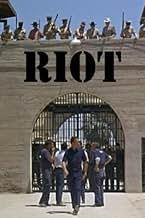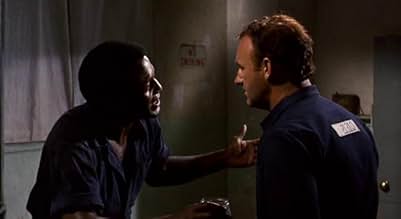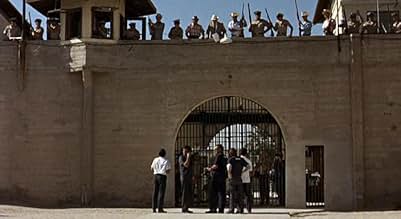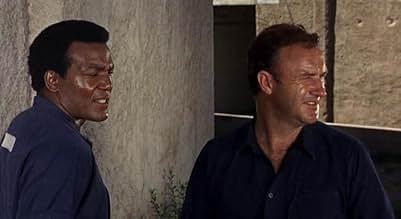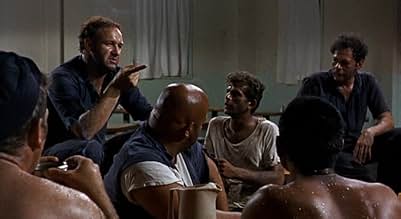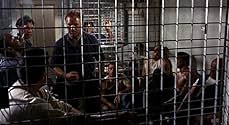Ajouter une intrigue dans votre langueA riot in a state prison is staged to cover up an escape attempt, during which many inmates and guards are killed. Shot on location at Arizona State Prison.A riot in a state prison is staged to cover up an escape attempt, during which many inmates and guards are killed. Shot on location at Arizona State Prison.A riot in a state prison is staged to cover up an escape attempt, during which many inmates and guards are killed. Shot on location at Arizona State Prison.
Avis en vedette
Small budget movie,which Gene Hackman's fans might want to see.Its main originality lies in the fact that it does not show life in prison,but the inmates' revenge ,after a few wardens have been held hostages .The prisoners try to fool the prison authorities as they write a petition in order to improve their living conditions in jail while digging a tunnel .But it's many a mile to freedom .Not as good as Siegel's "escape from Alcatraz" (both movies are reportedly true stories).Very violent ,mainly in the second half.
Note:the movie was produced by William Castle with a score by Christopher Komeda.This team worked on "Rosemary's baby" the year before.And "Riot" music resembles that of "Rosemary".Notably,the sequence when the men are walking through the tunnel uses almost the same music as the sequence when Rosemary ,with a knife in her hand,walks through the corridor that leads to the Castevet's apartment.
Note:the movie was produced by William Castle with a score by Christopher Komeda.This team worked on "Rosemary's baby" the year before.And "Riot" music resembles that of "Rosemary".Notably,the sequence when the men are walking through the tunnel uses almost the same music as the sequence when Rosemary ,with a knife in her hand,walks through the corridor that leads to the Castevet's apartment.
okay, here are what i don't think this movie and its screenplay are good enough: 1) never thought the black prisoners and the white ones could be so united in any prison history 2) the leader of the white prisoner, and the leader of the black ones seemed to respect each other quite well, they also cooperated with each other like brothers. the movie was released in 1969, and probably shot in the year before. do you think in that era and time frame, the blacks could have mixed with the whites so smoothly? they were used to be oil and water, they never could be mixed together, no matter what. 3) the black guy got a thick and high quality cow hide belt, and when he wanted to punch somebody, he just unbelted it from his waist and wrapped around his right fist. are you sure, dude? prisoners could have regular belts around his waists and never considered a dangerous weapon to other inmates and the prisons authorities? if shanks made in plastic or metal are considered deadly weapons, what about the belts? they could also be used as deadly weapons, don't you think? there are so many details that didn't feel all right but you can also let them go if you really need to watch a not quite exciting prison riot film but either a black prisoner's day dream or fantasy.
Every prison throughout the world, whether state or Federal is an enclosed pressure cooker capped by an ever tightening lid of anger, hate and frustration. Within the walls are a collection of unruly, unpredictable, undisciplined gathering of misfits, murderers and anti-social types. For the most part they are watched and guarded so they do not escape their confinement which is the location for the film called " Riot. " Jim Brown stars as Cully Briston with Gene Hackman as Red Fraker. Although, Cully is to be released in a couple of months, 'Red' and his fellow inmates stage a small takeover in the infirmary which spills over to the detention ward. Having little to do with the initial incident, Cully nevertheless becomes part of the escalating situation when he helps his friends. Gerald O'Loughlin, plays one of the more contentious prison guards who has been throwing his weight around for years in the prison, suddenly feigns sickly and fragile in the face of death. Meanwhile, the Warden who has been vacationing, returns and orders the prisoners to cease and desist. As he prepares to send in his Riot-Squads, the prisoners plan on escaping with an Indian guide called Surefoot. (Ben Carruthers) The seconds tick away and the situation becomes hopelessly unmanageable. The Warden, the Guards and the prisoners all await the next turn of events. Strong character drama from Brown, Hackman and Mike Kellin give this feature a realistic aura and one sure to make high drama for the audience. Good Film and one of the best performances for Jim Brown. ****
I realized in time for his centenary tribute that this tense jailbreak thriller was produced by William Castle; the film does not have much of a reputation, however, and is perhaps most notable for being one of a number of transitory parts for Gene Hackman between his acquiring fame in BONNIE AND CLYDE (1967) and stardom via THE FRENCH CONNECTION (1971) – another such effort, THE SPLIT (1968), had partnered him with Jim Brown (who also assumes the leading role here). Indeed, Hackman's superiority in the acting stakes – despite essentially playing second- fiddle to ex-American Football luminary Brown – in comparison to the other participants (more on this later) is palpable throughout. Having said that, Gerald S. O'Loughlin is initially set out as the prisoners' chief nemesis but his contribution gradually diminishes once the titular event takes centre-stage.
The movie is basically an updated and more brutal version of earlier prison dramas, the obvious prototype being Don Siegel's noir classic RIOT IN CELL BLOCK 11 (1954). What is interesting in this case is that the riot is borne out of an attempted mass escape of the isolation division; when the latter is foiled, mastermind Hackman decides to buy some time – ostensibly negotiating system reforms with the authorities on the outside (as it happens, the fearsome warden has chosen this precise moment to take a break!) – while a tunnel is being laboriously dug from under the auditorium to freedom just past the walls of the vast compound!! Incidentally, Castle is to be commended for shooting this in an authentic Arizona correctional facility – with not only the real-life warden filling his respective shoes within the narrative (I wonder whether he was aware of how unsympathetically his office was being depicted!) but also a number of the convicts themselves!!
As I said, the film features a number of contemporary trappings which, frankly, do it (and even more so the genre involved) no more than a disservice – notably a substance-fuelled party by the inmates, with a handful of them in drag so as to titillate their 'colleagues'; one of them even invites coloured macho Brown to his cell, but he obviously backs off (preferring to envision a clutch of bikini-clad 'sisters' in the movie's one scene with female presences, drooling over him)! Similarly over-the-top are the actions of a wacky knife-happy Indian who constantly antagonizes Brown, and whom Hackman needs tagging along in order to supply guidance in their eventual flight to Mexico only to have his throat memorably slit by him at their very moment of glory (many of the intended fugitives had already been routed by the shrewd warden)! Among the assets, then, are the pristine DVD-sourced look and Krzysztof Komeda's unusual score (albeit backed by a recurring wistful ballad that acts as Brown's theme tune), the esteemed Polish composer's last effort prior to his untimely tragic death – and which ties the picture with Castle's much more distinguished production ROSEMARY'S BABY (1968).
The movie is basically an updated and more brutal version of earlier prison dramas, the obvious prototype being Don Siegel's noir classic RIOT IN CELL BLOCK 11 (1954). What is interesting in this case is that the riot is borne out of an attempted mass escape of the isolation division; when the latter is foiled, mastermind Hackman decides to buy some time – ostensibly negotiating system reforms with the authorities on the outside (as it happens, the fearsome warden has chosen this precise moment to take a break!) – while a tunnel is being laboriously dug from under the auditorium to freedom just past the walls of the vast compound!! Incidentally, Castle is to be commended for shooting this in an authentic Arizona correctional facility – with not only the real-life warden filling his respective shoes within the narrative (I wonder whether he was aware of how unsympathetically his office was being depicted!) but also a number of the convicts themselves!!
As I said, the film features a number of contemporary trappings which, frankly, do it (and even more so the genre involved) no more than a disservice – notably a substance-fuelled party by the inmates, with a handful of them in drag so as to titillate their 'colleagues'; one of them even invites coloured macho Brown to his cell, but he obviously backs off (preferring to envision a clutch of bikini-clad 'sisters' in the movie's one scene with female presences, drooling over him)! Similarly over-the-top are the actions of a wacky knife-happy Indian who constantly antagonizes Brown, and whom Hackman needs tagging along in order to supply guidance in their eventual flight to Mexico only to have his throat memorably slit by him at their very moment of glory (many of the intended fugitives had already been routed by the shrewd warden)! Among the assets, then, are the pristine DVD-sourced look and Krzysztof Komeda's unusual score (albeit backed by a recurring wistful ballad that acts as Brown's theme tune), the esteemed Polish composer's last effort prior to his untimely tragic death – and which ties the picture with Castle's much more distinguished production ROSEMARY'S BABY (1968).
Buzz Kulik's pulpy, lurid Riot, an R-rated glob of clichéd prison- flick trash shows us two things:
1. Since this would be PG-13 now, with almost dirty language, sort- of naked prisoners being beaten, sparing gouts of blood, and way, way too much of a gay prisoner doing a bump and grind in his cell, one can marvel at how our tolerance of crudity has risen over the last five decades. Kulik must have been in constant combat with the standards and practices folks at Paramount, either to put more movies-sure-are-different adult stuff in this story of a riot masking an escape in an Arizona prison, or to clean this thing up, now!
2. Kulik's ability to take such a nasty, ugly, and pretty-much stupid prison-break story and infuse it with a professionalism the movie doesn't deserve is a testament to his talent. Jim Brown and Gene Hackman, along with a number of recognizable character actors and a whole bunch of real-life inmates are either catatonic or chew up scenery at an alarming rate. The stuff that comes out of their mouths could only be called dialogue in the most general sense of the word. In other words, Riot is a blob of sweat-covered clichés that, for some reason, is watchable enough to keep watching. Go figure!
I saw Riot the first time in, I think, 1973 when ABC showed it during the summer down-time. I could tell the movie had about a third lopped out for all the crudities and nudities and other prisonese. I could only imagine what the little old ladies with the pinking shears and the blue hair at ABC were snipping out, but I thought it was a pretty fearsome movie anyway.
Now, I just marvel at how far Riot pushes the edge of the envelope.
It's still a crappy movie, but it's also a snapshot of what a movie studio was willing to allow for public consumption, way back when you couldn't say "damn" on TV.
1. Since this would be PG-13 now, with almost dirty language, sort- of naked prisoners being beaten, sparing gouts of blood, and way, way too much of a gay prisoner doing a bump and grind in his cell, one can marvel at how our tolerance of crudity has risen over the last five decades. Kulik must have been in constant combat with the standards and practices folks at Paramount, either to put more movies-sure-are-different adult stuff in this story of a riot masking an escape in an Arizona prison, or to clean this thing up, now!
2. Kulik's ability to take such a nasty, ugly, and pretty-much stupid prison-break story and infuse it with a professionalism the movie doesn't deserve is a testament to his talent. Jim Brown and Gene Hackman, along with a number of recognizable character actors and a whole bunch of real-life inmates are either catatonic or chew up scenery at an alarming rate. The stuff that comes out of their mouths could only be called dialogue in the most general sense of the word. In other words, Riot is a blob of sweat-covered clichés that, for some reason, is watchable enough to keep watching. Go figure!
I saw Riot the first time in, I think, 1973 when ABC showed it during the summer down-time. I could tell the movie had about a third lopped out for all the crudities and nudities and other prisonese. I could only imagine what the little old ladies with the pinking shears and the blue hair at ABC were snipping out, but I thought it was a pretty fearsome movie anyway.
Now, I just marvel at how far Riot pushes the edge of the envelope.
It's still a crappy movie, but it's also a snapshot of what a movie studio was willing to allow for public consumption, way back when you couldn't say "damn" on TV.
Le saviez-vous
- AnecdotesArizona State Penitentiary warden Frank Eyman and 600 inmates and prison staff appear in the movie.
- Autres versionsAn edited, "PG" rated version was released to theaters in 1970. Video version is the complete "R" rated version.
- ConnexionsReferenced in Summer in the City (1971)
- Bandes originalesRAG MOP
Words and Music by Johnny Lee Wills and Deacon Anderson
Meilleurs choix
Connectez-vous pour évaluer et surveiller les recommandations personnalisées
- How long is Riot?Propulsé par Alexa
Détails
- Durée1 heure 36 minutes
- Mixage
- Rapport de forme
- 1.85 : 1
Contribuer à cette page
Suggérer une modification ou ajouter du contenu manquant


